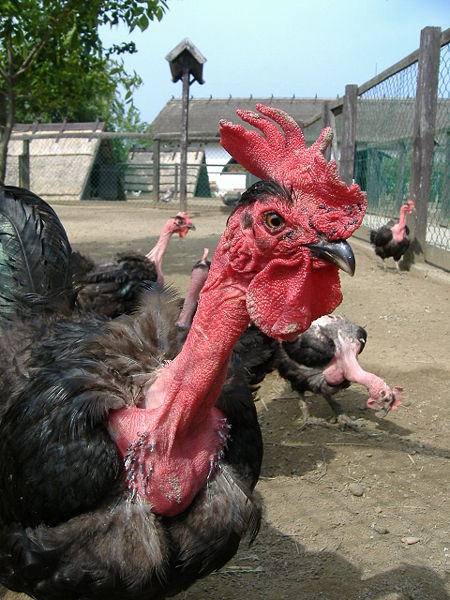Find out the secret of snake neck chicken
The long and hairless neck of snake neck chicken is the result of a random genetic modification, a study showed.

Solid ancient chickens.Photo Bukisa
Snake neck chicken (or Transylvania chicken) is a chicken that has a long, hairless neck. They originate from Hungary.
Previously, it was mistakenly thought that they were a hybrid product of ordinary chicken and turkey. Today snake neck chicken is quite popular in Europe, but in America their number is quite low.The hairless neck is a dominant trait controlled by a gene and can be transmitted to other chickens, but the ones inheriting that trait are hybrid chickens, not true snake neck chickens.
Denis Headon, an evolutionary biologist of the Roslin Institute of Edinburgh University in Scotland, analyzed the DNA of snake neck chickens to understand the nature of their neck. He and his colleagues found that hairlessness was the result of a random genetic mutation . This mutation causes the chicken body to produce too much BMP12 - a molecule that prevents hair growth. It first appeared in chickens raised in northern Romani several hundred years ago, National Geographic said.
When the team put BMP12 molecules into the chicken embryos often in the lab, they didn't have feathers on their necks as they grew. So neck is the most sensitive part for BMP12.
Continuing DNA analysis, the experts discovered an acid derived from the skin on the neck of snake neck chicken. This acid increases the ability of BMP12 to work, making it impossible for hair to grow.
Most mutations of genes that bring bad effects to animals, mutated genes in solid neck chickens bring many benefits to them. In fact, snake neck chickens are famous all over the world because they have better heat resistance, have a higher body weight and lay more eggs than other chickens. These advantages are important for chicken farming in hot climates like Mexico.
Snake neck chicken is not the only chicken without hair on the neck.
' We think the necks of all chickens tend to lose their hair. If a gene mutation increases the number of BMP12 molecules in the skin, the neck will be the first to lose hair , 'Headon said.
For example, in nature, ostriches and storks do not have feathers in their necks to resist heat in this part. Scientists do not know if BMP12 is the culprit that makes their necks without feathers.
" The evolution makes birds lose their feathers easily if they live in a hot environment and their body size is large ," Headon said.
- The bizarre appearance of snake neck turtles
- The section of the strange and expensive chicken market attracted the soul of the rich Vietnamese family
- Experts reveal 6 types of delicious meat also should not eat, some also cause loss of life
- Why cobra neck is wide armchairs?
- Cobras snuggle around the mid-way neck
- Chicken thighs: West doesn't like why we like it?
- The mongoose dragged the poisonous serpent on the tree to eat meat
- The golden snake tree plays a gecko in the secret
- People should not eat chicken
- Loch Ness monster-like object glides on Canadian surface
- Unbelievable sight: Chicken sleeping with snakes
- The 23-year-old girl is half-paralyzed because of an action many people do when tired
 Animal 'suffering' after hibernation
Animal 'suffering' after hibernation Why do goats climb well?
Why do goats climb well? Scientists were surprised to see chimpanzees eating turtles
Scientists were surprised to see chimpanzees eating turtles Giant catfish died deadly due to drought in Thailand
Giant catfish died deadly due to drought in Thailand Why can neck and shoulder massage be deadly?
Why can neck and shoulder massage be deadly?  The ancient female vampire's grave is still 'sealed'
The ancient female vampire's grave is still 'sealed'  The shocking part that upgrades the Jurassic 'snake head' into a monster
The shocking part that upgrades the Jurassic 'snake head' into a monster  A simple way to check your thyroid at home
A simple way to check your thyroid at home  Regardless of whether male or female, these two parts of the body are bigger and more life-threatening
Regardless of whether male or female, these two parts of the body are bigger and more life-threatening  Pain in the neck, shoulders, or neck is not caused by sitting in the wrong position!
Pain in the neck, shoulders, or neck is not caused by sitting in the wrong position! 